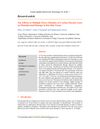technique to create small wounds in skin to activate collagen production and hair growth
herb and oil thought to stimulate skin and hair
glycoprotein that inhibits TGF-β and promotes hair growth by antagonizing activin
chemical from L'Oreal that encourages hair to enter growth phase


